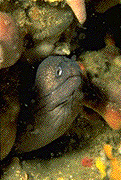Moray eel: Difference between revisions
No edit summary |
GrahamBould (talk | contribs) m rv - fish names are lower case |
||
| Line 13: | Line 13: | ||
}} |
}} |
||
'''Moray |
'''Moray eels''' are large [[cosmopolitan (species)|cosmopolitan]] [[eel]]s of the [[family (biology)|family]] '''Muraenidae'''. There are approximately 200 species in 15 genera. The typical length for a moray is 1.5m (5 feet), with the largest being the [[slender giant moray]], ''Strophidon sathete'', at up to 4 m (13 feet). |
||
[[Image:Muraena retifera.jpg|thumb|left|[[Reticulate moray]],<br>''[[Muraena retifera]]'']] |
[[Image:Muraena retifera.jpg|thumb|left|[[Reticulate moray]],<br>''[[Muraena retifera]]'']] |
||
Moray eels frequent tropical and subtropical [[coral reef]]s to depths of 200 m, where they spend most of their time concealed inside crevices and alcoves. They secrete a protective mucus over their scaleless skin which contains a toxin in some species. Their small circular [[gill]]s, located on the flanks far posterior to the mouth, require the moray eel to maintain a gape in order to facilitate respiration. |
Moray eels frequent tropical and subtropical [[coral reef]]s to depths of 200 m, where they spend most of their time concealed inside crevices and alcoves. They secrete a protective mucus over their scaleless skin which contains a toxin in some species. Their small circular [[gill]]s, located on the flanks far posterior to the mouth, require the moray eel to maintain a gape in order to facilitate respiration. |
||
Revision as of 08:17, 13 April 2007
| Moray eel | |
|---|---|

| |
| Scientific classification | |
| Kingdom: | |
| Phylum: | |
| Class: | |
| Order: | |
| Family: | Muraenidae
|
| Genera | |
|
See text. | |
Moray eels are large cosmopolitan eels of the family Muraenidae. There are approximately 200 species in 15 genera. The typical length for a moray is 1.5m (5 feet), with the largest being the slender giant moray, Strophidon sathete, at up to 4 m (13 feet).

Muraena retifera
Moray eels frequent tropical and subtropical coral reefs to depths of 200 m, where they spend most of their time concealed inside crevices and alcoves. They secrete a protective mucus over their scaleless skin which contains a toxin in some species. Their small circular gills, located on the flanks far posterior to the mouth, require the moray eel to maintain a gape in order to facilitate respiration.
The dorsal fin extends from just behind the head, along the back and joins seamlessly with the caudal and anal fin. Most species lack pectoral and pelvic fins, adding to their snake-like appearance. Their eyes are rather small; morays rely on their highly developed sense of smell, lying in wait to ambush prey.
Their bodies are patterned, camouflage also being present inside the mouth. Their jaws are wide, with a snout that protrudes forward. They possess large teeth, designed to tear flesh as opposed to holding or chewing. They are capable of inflicting serious wounds to humans.
Morays are carnivorous and feed primarily on other fish, cephalopods, mollusks, and crustaceans. Groupers, other moray eels, and barracudas are among their few predators. There is a commercial fishery for several species, but some have been known to cause ciguatera fish poisoning. Morays hide in crevices in the reefs, and wait until their prey is close enough for capture. They then jump out and clamp the prey in their strong jaws.
Cooperative Hunting

Rhinomuraena quaesita
In the December 2006 issue of the journal, Public Library of Science Biology, a team of biologists announced the discovery of interspecies cooperative hunting involving Morays. The biologists, who were engaged in a study of Red Sea cleaner-fish (fish that enter the mouths of other fish to rid them of parasites), discovered that a species of grouper, Plectropomus Pessuliferus, often recruited moray eels to aid them while hunting for food. This is the first discovery of cooperation between fish in general, and the first known inter-species cooperation outside of humans and dogs, humans and falcons, humans and cats, and humans and dolphins.[1] [2]
Genera
- Anarchias
- Channomuraena
- Cirrimaxilla
- Echidna
- Enchelycore
- Enchelynassa
- Gymnomuraena
- Gymnothorax
- Monopenchelys
- Muraena
- Pseudechidna
- Rhinomuraena
- Scuticaria
- Strophidon
- Uropterygius
